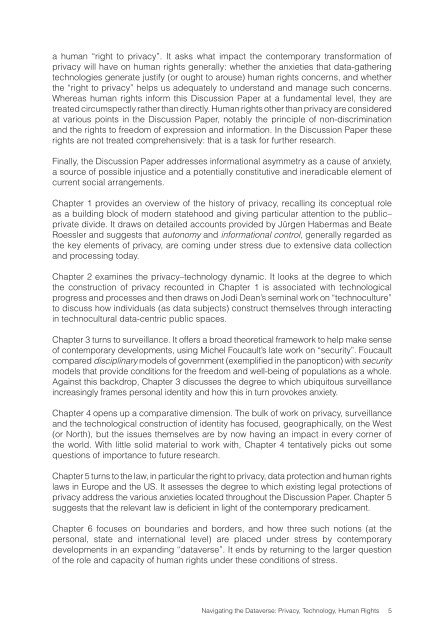Navigating the Dataverse: Privacy, Technology ... - The ICHRP
Navigating the Dataverse: Privacy, Technology ... - The ICHRP
Navigating the Dataverse: Privacy, Technology ... - The ICHRP
Create successful ePaper yourself
Turn your PDF publications into a flip-book with our unique Google optimized e-Paper software.
a human “right to privacy”. It asks what impact <strong>the</strong> contemporary transformation of<br />
privacy will have on human rights generally: whe<strong>the</strong>r <strong>the</strong> anxieties that data-ga<strong>the</strong>ring<br />
technologies generate justify (or ought to arouse) human rights concerns, and whe<strong>the</strong>r<br />
<strong>the</strong> “right to privacy” helps us adequately to understand and manage such concerns.<br />
Whereas human rights inform this Discussion Paper at a fundamental level, <strong>the</strong>y are<br />
treated circumspectly ra<strong>the</strong>r than directly. Human rights o<strong>the</strong>r than privacy are considered<br />
at various points in <strong>the</strong> Discussion Paper, notably <strong>the</strong> principle of non-discrimination<br />
and <strong>the</strong> rights to freedom of expression and information. In <strong>the</strong> Discussion Paper <strong>the</strong>se<br />
rights are not treated comprehensively: that is a task for fur<strong>the</strong>r research.<br />
Finally, <strong>the</strong> Discussion Paper addresses informational asymmetry as a cause of anxiety,<br />
a source of possible injustice and a potentially constitutive and ineradicable element of<br />
current social arrangements.<br />
Chapter 1 provides an overview of <strong>the</strong> history of privacy, recalling its conceptual role<br />
as a building block of modern statehood and giving particular attention to <strong>the</strong> public–<br />
private divide. It draws on detailed accounts provided by Jürgen Habermas and Beate<br />
Roessler and suggests that autonomy and informational control, generally regarded as<br />
<strong>the</strong> key elements of privacy, are coming under stress due to extensive data collection<br />
and processing today.<br />
Chapter 2 examines <strong>the</strong> privacy–technology dynamic. It looks at <strong>the</strong> degree to which<br />
<strong>the</strong> construction of privacy recounted in Chapter 1 is associated with technological<br />
progress and processes and <strong>the</strong>n draws on Jodi Dean’s seminal work on “technoculture”<br />
to discuss how individuals (as data subjects) construct <strong>the</strong>mselves through interacting<br />
in technocultural data-centric public spaces.<br />
Chapter 3 turns to surveillance. It offers a broad <strong>the</strong>oretical framework to help make sense<br />
of contemporary developments, using Michel Foucault’s late work on “security”. Foucault<br />
compared disciplinary models of government (exemplified in <strong>the</strong> panopticon) with security<br />
models that provide conditions for <strong>the</strong> freedom and well-being of populations as a whole.<br />
Against this backdrop, Chapter 3 discusses <strong>the</strong> degree to which ubiquitous surveillance<br />
increasingly frames personal identity and how this in turn provokes anxiety.<br />
Chapter 4 opens up a comparative dimension. <strong>The</strong> bulk of work on privacy, surveillance<br />
and <strong>the</strong> technological construction of identity has focused, geographically, on <strong>the</strong> West<br />
(or North), but <strong>the</strong> issues <strong>the</strong>mselves are by now having an impact in every corner of<br />
<strong>the</strong> world. With little solid material to work with, Chapter 4 tentatively picks out some<br />
questions of importance to future research.<br />
Chapter 5 turns to <strong>the</strong> law, in particular <strong>the</strong> right to privacy, data protection and human rights<br />
laws in Europe and <strong>the</strong> US. It assesses <strong>the</strong> degree to which existing legal protections of<br />
privacy address <strong>the</strong> various anxieties located throughout <strong>the</strong> Discussion Paper. Chapter 5<br />
suggests that <strong>the</strong> relevant law is deficient in light of <strong>the</strong> contemporary predicament.<br />
Chapter 6 focuses on boundaries and borders, and how three such notions (at <strong>the</strong><br />
personal, state and international level) are placed under stress by contemporary<br />
developments in an expanding “dataverse”. It ends by returning to <strong>the</strong> larger question<br />
of <strong>the</strong> role and capacity of human rights under <strong>the</strong>se conditions of stress.<br />
<strong>Navigating</strong> <strong>the</strong> <strong>Dataverse</strong>: <strong>Privacy</strong>, <strong>Technology</strong>, Human Rights
















